What is the technology behind connecting sensors and devices to the Internet and why is this critical?
What is the Industrial Internet of Things (IIoT)?
Industrial Internet of Things (IIoT) is a computing concept which defines how a combination of hardware, software, sensors, actuators, and related capabilities can be used to connect physical devices to the internet and enable them to identify themselves to other devices. In very simple words, IIoT can enable the remote management and monitoring of the health of any electronic device through the internet.
IIoT enabled devices communicate data across a wide spectrum of industrial equipment and assets in manufacturing, metal and mining, energy, and other industrial environments.
In the Oil and Gas industry, activities and processes are complex, capital intensive and critical. From drilling equipment, pipelines, transportation, logistics to refinery operations, there are many assets that need to be monitored along the way with each one being more mission critical and a greater security risk than the next. All parts of the Oil and Gas value chain – upstream, midstream, or downstream – are embracing the twenty first century technology renaissance and adopting IIoT principles in their operations and decision making. IIoT enables the Oil and Gas industry to make real-time decisions, reduce equipment failure, increase safety, minimize downtime, and reduce wastage, resulting in greater operations efficiency, reliability, and performance with complete plant automation. Similarly, chemicals manufacturing, water treatment, metals and mining, and power generation companies are adopting the IIoT to make real-time decisions and enhance productivity.
The global IIoT market size is expected to grow from USD 65 billion in 2018 to USD 118 billion by 2025, at a Compound Annual Growth Rate (CAGR) of 8.83% during the forecast period 2025. The growth of the IIoT industry is driven by factors such as technological developments in semiconductors and electronic devices, increased use of cloud computing systems, standardization of IPv6, and funding for IIoT related R&D activities from governments.
How can IIoT and Digital Transformation (DX) dramatically improve operations performance
IIoT can transform some existing business processes and can be implemented with a change management approach to all IIoT projects big and small.
As an example, for Asset Management, IIoT-enabled smart asset monitoring solutions can perform all the traditional functions like location monitoring, condition monitoring, asset lifecycle management and process control. In addition, it delivers intelligence to automated workflows, real-time alerts, insights from data, dynamic edge control of assets, predictive maintenance, cross-domain analytics, and real-time visibility.
Some key advantages that can be obtained with IIoT include:
- Increased productivity resulting in higher ROI
- Lower maintenance costs
- Reduced unplanned downtime caused by failure of assets
The combination of IIoT and DX allows for the automation and democratization of data. IIoT enables information to be deployed via DX systems to the different levels of any operation. When this information is visible in an easy-to-consume package to the different units and stakeholders across the organization (dashboards, online reports, alarms, etc.), these entities can act in unison to respond to the ever-changing process parameters of the operation. This means that if there is a business opportunity to be captured, the entire plant can react as a single unit to take advantage of it and react rapidly and effectively to it.
As an example, when a hurricane hits the gulf coast during the summer months, plants in the affected areas must shut down to weather the storm. This creates an opportunity for surrounding refineries, outside the hurricane path, to increase production and fill the void in gasoline created by these shutdowns. This is a short period of time that a refinery will be down, 7 to 10 days at most, but it will competitors that are best prepared to act upon this void to increase sales of their fuel products and fill that void.
A refinery that is trying to capture this opportunity ramps up production by first increasing feed to the Crude Unit. All other units will have to react accordingly to this operations switch and produce fuels that meet specifications. Decision have to be made on how to best route the increase in crude unit product streams if, at current conditions prior to increase, any other units were at capacity. The refinery that can make the fastest decisions and make fuel products “on spec” will be the first vendor to fill this void and capture the lion’s share of the business opportunity.
IIoT and DX systems will enable these refineries to act upon these opportunities more rapidly and efficiently. As the information is exposed to the operations team in real time, with actionable insights on how to adapt to the changes necessary to successfully make product, the plants will be able to capture a greater market share than their peers during this window of opportunity.
The schematic below depicts some of these principles and the key role of IIoT in enabling the digital transformation from the perspective of OLI Systems and electrolyte chemistry-based process simulation.
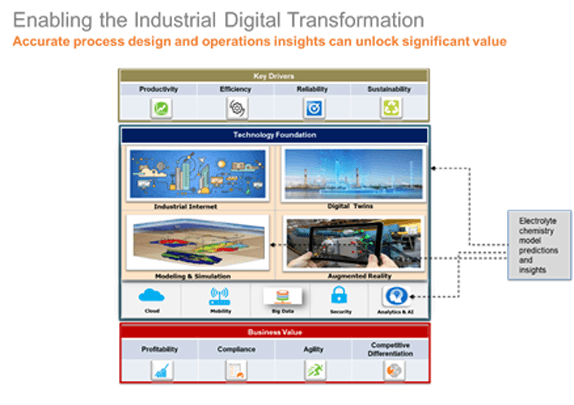
An Illustrative example of IIoT principles
Collecting data from sensors and devices, monitoring them, and allowing them to communicate with each other are foundational elements required for the Industrial Digital Transformation.
This is an illustrative example of how IIoT can be used in any industrial application. We are using Arduino micro controller, ESP8266 with AWS IIoT service in this example.
In this example, we show how to write a program to post the Temperature readings from the device to AWS IIoT, perform a calculation on it and turn on different LEDs based on the readings (other input readings can be pressure, flow, composition etc.). These are common types of calculations in industrial applications. Let’s get started.
The first step is to setup the microcontroller, with LED’s and thermistor as shown in the image below
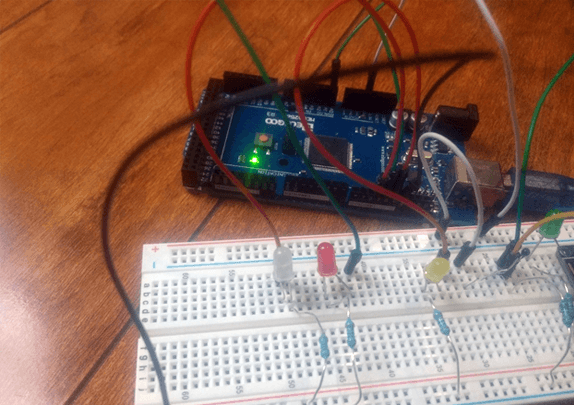
We are using Arduino IDE to upload the code shown below and test how our setup works.
void setup() {
Serial.begin(9600);
pinMode(RED_LED, OUTPUT);
pinMode(WHITE_LED, OUTPUT);
pinMode(YELLOW_LED, OUTPUT);
}
void loop() {
value = analogRead(A0);
volts=(value/1024.0)*5.0;
temp= volts*100.0;
tempF=(temp*9/5)+32;
if (tempF > 65) {
digitalWrite(RED_LED, HIGH);
digitalWrite(WHITE_LED, LOW);
digitalWrite(YELLOW_LED, LOW);
} else if (tempF > 63 && tempF < 65){
digitalWrite(YELLOW_LED, HIGH);
digitalWrite(RED_LED, LOW);
digitalWrite(WHITE_LED, LOW);
} else {
digitalWrite(YELLOW_LED, LOW);
digitalWrite(RED_LED, LOW);
digitalWrite(WHITE_LED, HIGH);
}
Serial.print("Temperature: ");
Serial.print(tempF);
Serial.println(" F");
delay(500);
}
The LED, which is white under normal conditions, will turn to YELLOW and RED as the temperature increases
The second step is to set up the IIoT. The following tasks need to be completed in this step.
Login into AWS console.
Search for IIoT Service
Then create a “thing” in AWS IIoT for tracking an asset.
- Let’s name it “boiler”
- Click Create
- Click on the thing to connect device. This will connect certificates to connect to the thing securely. Download public key, private key, certificate, and root certificate
- Make a note of AWS Host, MQTT topic name
The third step is to set up ESP8266, it’s a Wi-Fi module to send data to AWS IIoT using the connection shown in the image below.
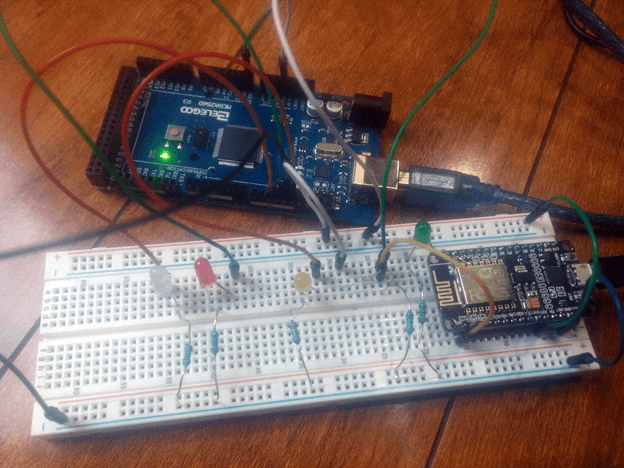
Use the code below to post to AWS. The code Below will send thermistor temperature data
AWS_IIOT aws;
void setup()
{
Serial.begin(9600);
WiFi.begin(WIFI_SSID, WIFI_PASSWD);
while (WiFi.status() != WL_CONNECTED)
{
Serial.print(".");
delay(500);
}
Serial.println("WIFI Connected");
Serial.println("Connecting to AWS");
if (aws.connect(AWS_HOST, CLIENT_ID) == 0)
{ // connects to host and returns 0 upon success
Serial.println("AWS Connection successful");
}
else
{
Serial.println("AWS Connection failed!");
}
Serial.println("Completed");
}
void loop()
{
int value = analogRead(A0);
float volts = (value / 1024.0) * 5.0;
float temp = volts * 100.0;
//create string payload for publishing
String mqttPayload = "Temperature: ";
mqttPayload += String(temp);
mqttPayload += "°C ";
char payload[40];
mqttPayload.toCharArray(payload, 40);
Serial.println("Publishing:- ");
Serial.println(payload);
if (aws.publish(MQTT_TOPIC, payload) == 0)
{ // publishes payload and returns 0 upon success
Serial.println("MQTT Publish Success");
}
else
{
Serial.println("MQTT Publish Failed!\n");
}
delay(1000);
}
Finally, we will subscribe to a topic, make an api call to OLI Process API endpoint,
and post the received data along with the deviceId. We will turn the LED on based on the data received:
void callback(char* topic, byte* payload, unsigned int length) {
char led = (char)payload[62];
Serial.println(led);
if(led==49)
{
digitalWrite(D1, HIGH);
}
else
{
digitalWrite(D1, LOW);
}
Serial.println();
}
AWS Dashboard Picture

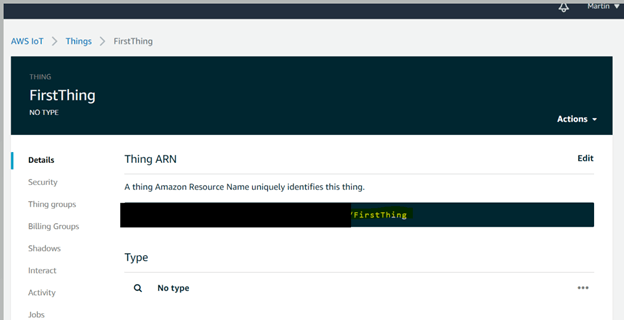
As we have shown above, it is quite simple to set up an IIoT application.
In this case, we presented an application of an IIoT device and demonstrated how it can be integrated to an API. However, the opportunities to create additional applications are endless. IIoT acts as soft link between the physical assets, IT infrastructure and APIs and is a key enabler of real-time monitoring of plant, control, corrosion/scaling, prescriptive and predictive maintenance, failure analysis, etc., to make industrial operations more efficient and effective.
Summary:
The benefits of a well-executed IIoT capability can be very rewarding for industrial companies. The OLI Systems REST APIs that will be available in early 2021 are designed for simple, secure, and easy integration with IIoT devices to accelerate IIoT and digital transformation initiatives. IIoT devices (assets) can be integrated with OLI REST API seamlessly to deliver data, perform the computation, and deliver results back to the device or another web application or repository. Figure 1 represents a conceptual view of OLI’s-IIoT device-based architecture for corrosion prediction/monitoring integrated to OLI’s digital twin. The capability to harness sensor data and take actions based on that information is critical for successful deployment of IIoT projects.
Figure 1: Schematic of IIoT with Soft Sensors and Digital Twins
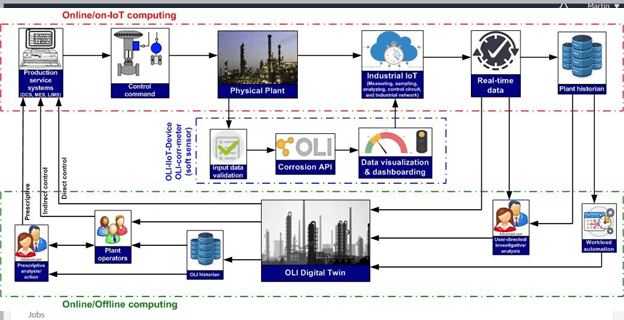
Register at www.olisystems.com/contact to learn more about OLI’s vision and capability development roadmap for IIoT, Digital Twins and Digital Transformation. You can also email [email protected] to engage directly with our sales team and discuss how our process simulation solutions can help you with your digital transformation initiatives.
